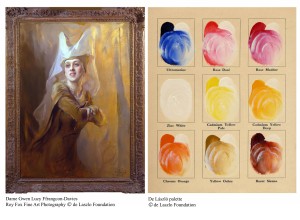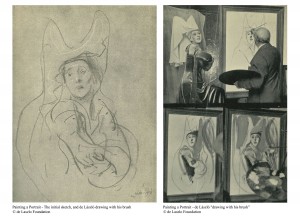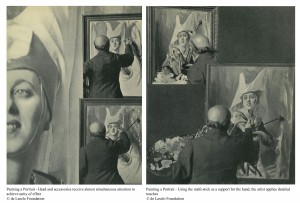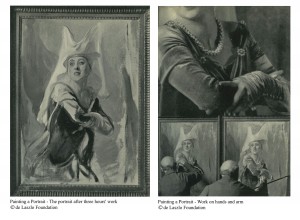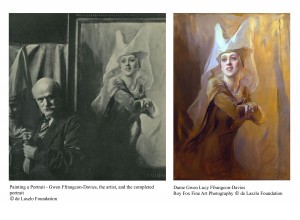De László's Technique and Frames
Early Method
De László's training was traditionally academic and made use of multiple preparatory drawings, often life-size, which he would use to paint the finished portrait. Examples include preparatory works for the group portraits of the de Gramont and Kupelwieser families painted in 1902 and 1905 respectively. He would then draw the figure in detail on the canvas before starting to paint. The artist later commented on his early method saying that it was “the way of youthful inexperience and uncertainty.”[1]
Painting a Portrait
In 1934 de László co-operated on a book about his technique with his close friend, the art critic Alfred Lys Baldry. Painting a Portrait[2] illustrates step-by-step the process of painting a portrait of the actress Dame Gwen Ffrangcon-Davies. Beginning with his palette de László the colours “in the order in which [he] put them on his palette – ultramarine, madder, rose madder, zinc white, light cadmium, dark cadmium, yellow ochre, burnt sienna” and, when needed, “ivory black, Veronese green, Lac garance and orange cadmium.”[3]
He used poppy oil as a medium, because it dried slowly and suited his alla prima technique. He usually avoided mixing more than two colours on the palette at any time “for the sake of purity.” Instead he applied individual hues “wet in wet” directly onto the canvas.
De László would then do a rapid sketch in charcoal or pencil to determine the composition of the painting. For his most important commissions he would usually make a sketch in oil “to judge the effect of the colour scheme.”[4]
He started on a blank canvas in its frame (see below) “painting a few lines to indicate the placing of the figure on the canvas.” He then focused on the head “seeking to express by means of light and shade the construction of the skull and defining accurately the larger planes”[5] in “a process of gradual building up…[which] must be done rapidly and directly.”[6] He would, to use his favourite expression, “draw with [his] brush” to develop the likeness. Before finishing the head de László would paint the sitter's surroundings to ensure the harmony of the composition. Once the head was finished he painted the sitter’s hands and feet, if shown, and then the rest of the body.
If de László was unsatisfied with a portrait he would invariably abandon the canvas or board to start on a new one. Sometimes using the verso of a rejected work.
Study Portraits
De László is well known for his study portraits or portrait sketches as he would sometimes call them. These were painted on canvas, unprimed millboard, or artist’s board and deliberately left “unfinished.” The composition were freely painted, with more detail given to the face and the dress loosely indicated with a few lines. These studies are unique to his oeuvre and exemplify his fluid technique and vigorous brushwork. De László considered them as a sub-genre of portraiture. From the 1920s patrons often asked specifically for study portraits because he could paint these at great speed in one or two sittings of two to three hours. Letters from the artist’s archive suggest that he had the artist boards shipped from Dury & Konrad Barth’s in Munich until the mid-1920s.[7]
Click here to see footage of de László painting the portrait of a model from the fashion house "Lucile." London Fine Art Studios have also made a film discussing and demonstrating his techniques, which can be seen here.
Frames
De László believed that the frame formed an integral part of the portrait and regularly painted the canvas in the chosen frame. If patrons did not have a suitable antique frame in their collection de László would recommend a frame from Emile Remy (153 King’s Road London) or Frederick Buck. In a letter dated 1934, however, de László wrote to Lord Airlie: “I would propose to get the frame from A. Martin, of 45 Lawn Road, N.W.3 who is usually more moderate than Pynappel, who is the very best, or some of the others.”[8] When working in Paris de László always used Edouard Grosvallet for his framing.
Click here for an article by Lynn Roberts on de László and picture framing.
Varnishing
De László did not always varnish his portraits himself as he became increasingly busy. He recommended that they be varnished professionally with Vibert's “vernis à retoucher.”
________________________________
[1] Rutter, Owen, Portrait of a Painter, London, 1939, p. 135
[2] Holme, C.G., ed., Painting a Portrait by de László, in How To Do It Series No.6, Introduction by A.L Baldry, The Studio, 1934
[3] Ibid., p. 12
[4] Ibid., p. 16
[5] Ibid., p. 18
[6] Ibid., p. 18
[7] DLA015-0028, letter from Mrs Carl Valentin to de László, 29 February 1924; DLA003-0071, letter from Frederick Cullen to de László, 9 September 1914
[8] DLA052-0056, letter from de László to Lord Airlie, 31 December 1934

